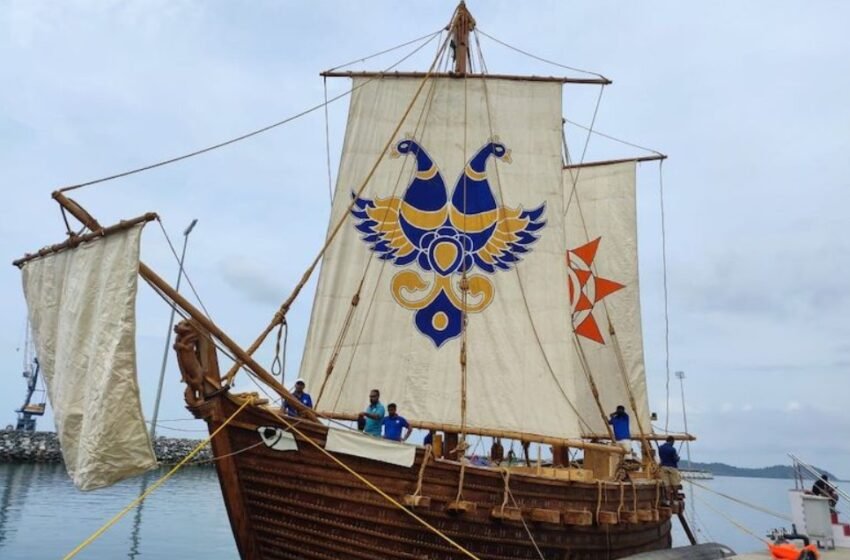Past Brought to Life Again: The Revival of INSV Kaundinya

–Bhoomee Vats
In a time when automated machines, computerized navigation, and steel warships are very common, the induction ceremony of the Indian Naval Sailing Vessel (INSV) Kaundinya took place at the Naval Base of Karwar, on 21st May, 2025. The stitched-plank sailing ship was traditionally crafted and was based on the 5th-century CE depiction of a ship in the Ajanta Caves. Stitched-plank is an ancient technique in which wooden planks are bound together using coconut husk, called coir, and natural resins. The ship is not merely just a vessel; it is India’s tribute to its rich maritime heritage, which existed even millennia ago.
The revival of this naval vessel is more than just a remembrance of history; it is a declaration, an announcement about how India values its own culture and seeks to celebrate its history in the form of soft power in the current modernistic geopolitical landscape. The ship retraces the past and continues its voyage into contemporary times where each and every one of its planks tell a different story and each whisper of the wind to the sails makes it go forward more and more.
History and Origin
The name INSV Kaundinya was inspired by Kaundinya I, a historic Indian mariner and sage who is said to have sailed from the Indian subcontinent to Southeast Asia in the early centuries CE. According to historical records and Southeast Asian inscriptions, Kaundinya arrived in Funan (modern-day Cambodia) and married Queen Soma, a warrior princess, with whom he established a reigning dynasty. Their story is more than just mythology; it is an important early example of India’s transoceanic cultural contacts, demonstrating how Indian maritime activity created political, spiritual, and commercial networks across the Indian Ocean. The Indian Navy’s decision to name the ship after this historical figure not only commemorates a forgotten seafarer but also reclaims India’s proper place in the lengthy and sometimes overlooked history of world navigation.
The vessel’s design reinforces this historical connection. INSV Kaundinya is based on ship drawings found in the Ajanta Caves, which date back to the fifth century CE and highlight India’s advanced shipbuilding and nautical heritage. This vessel is a potent symbol of civilizational continuity because it revives this shipbuilding art and names the vessel after a legendary sailor-king. This serves as a reminder to the world that India was once a thriving maritime power whose ships transported ideas, stories, and culture across vast oceans in addition to goods.
Craftsmanship Behind INSV Kaundinya
INSV Kaundinya was built utilizing a traditional stitched-plank technique, which involves tying wooden planks together with coir rope and sealing them with natural resins, making it completely metal-free. Traditional shipbuilders from Kerala, led by master artisan Babu Sankaran, revived this centuries-old technique with assistance from the Indian Navy, the Ministry of Culture, and IIT Madras. The vessel is inspired by ship artwork found in the Ajanta Caves and highlights India’s rich maritime tradition. Its handcrafted design and traditional symbolism elevate it to more than just a ship; it is a living link to the past and a proud reminder of India’s ocean-going heritage.
The ship has three masts (main, mizzen, and bowsprit), square sails, and long steering oars, which recall historical navigation tactics before the creation of the rudder. The sails are embellished with culturally significant symbols such as the Gandabherunda, a mythological two-headed eagle symbolizing strength, and the Sun, which represents energy and divinity. The bow has a carved Simha Yali, a protecting lion-like creature from South Indian mythology, and the deck has a stone anchor modelled after those used during the Harappan era. Together, these features transform the vessel into a moving work of art that honours India’s maritime ingenuity, spiritual imagery, and long-standing tradition.
Induction and Future Journeys
The Indian Navy officially commissioned INSV Kaundinya on May 21, 2025, at Karwar Naval Base in Karnataka. Union Culture Minister Gajendra Singh Shekhawat attended the ceremony, highlighting the ship’s cultural and historical significance. Its induction highlights a one-of-a-kind moment in which heritage and naval capacity intersect in a significant way. The ship is scheduled to recreate old maritime trade routes, commencing with a journey from Gujarat to Oman. INSV Kaundinya, manned by navy personnel and trained traditional sailors, would act as a floating ambassador of India’s maritime past, promoting cultural diplomacy and presenting the country’s oceanic legacy to the world.
INSV Kaundinya also plays an important role in educating and motivating future generations about India’s marine heritage. By combining conventional shipbuilding with active naval involvement, the vessel transforms into a dynamic learning tool for exhibitions, naval outreach programs, and cultural events. It serves to bridge the gap between ancient knowledge and modern thinking by demonstrating how history may be lived, rather than only studied in books or museums.
Sailing with Purpose
Beyond being a historic ship, INSV Kaundinya holds strategic and cultural significance. It revives India’s ancient nautical traditions and serves as a form of cultural diplomacy, especially in the Indo-Pacific region. By retracing traditional sea routes to Oman and Southeast Asia, it highlights India’s historical role in trade and cross-cultural exchanges.
The ship also connects people to the past in an intriguing way. Kaundinya, which appears in exhibitions and naval outreach programs, serves as a floating symbol of tradition and education. It instills pride in local handicrafts and promotes interest in India’s maritime heritage among the general public and students alike.
Conclusion
INSV Kaundinya is more than just a historic vessel; it represents a proud resurgence of India’s long-standing nautical identity. At a time when global narratives frequently neglect India’s ancient contributions to seafaring, this ship reminds us that even before modern warships and cargo fleets, Indian sailors had been crossing huge oceans, establishing trade routes, and encouraging cultural exchanges throughout Asia and beyond. Kaundinya revives forgotten stories with its traditional structure, symbolic design, and historical name.
By combining historical craftsmanship with a new purpose, the vessel becomes a one-of-a-kind representation of heritage and forward-thinking vision. Its trips will not only promote international marine links, but will also encourage the next generation to learn from the past. Kaundinya sails across the oceans carrying not only a crew but also a history of exploration, wisdom, and perseverance. It is a touching monument to India’s cultural depth and a beacon for rediscovering the wisdom of our oceans.


